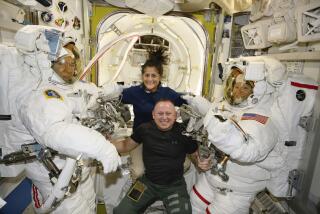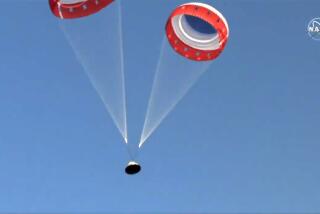Another Glitch as Repair Crew Docks With Mir
- Share via
KOROLEV, Russia — Two cosmonauts on a mission to fix the Mir space station ran into trouble Thursday when the automatic guidance system failed just as they reached the ship and they had to dock using manual controls.
In a striking parallel to Mir’s disastrous collision with an unmanned cargo ship in June, the capsule carrying the two Russians did not align itself properly for docking and was on course to hit the station.
When the Soyuz capsule was only 10 yards away, commander Anatoly Solovev recognized that his craft was off target and overrode its automatic controls.
A veteran of four previous flights to Mir, Solovev backed up the capsule, maneuvered into position and successfully docked on his first manual attempt. Ninety minutes later, the cosmonauts opened the hatch leading to Mir and greeted their three colleagues already aboard--two Russians and an American.
Russian space officials, who are eager for the new arrivals to repair damage from the June 25 collision and revive Mir’s scientific laboratories, dismissed the failure in the same calm manner they have minimized other recent setbacks with the 11-year-old station.
“It was a technical malfunction,” said Mission Control chief Vladimir Solovev (who is not related to the commander). “The situation was not a critical one, but we will look into it.”
After a 49-hour flight through space, commander Solovev and first-time cosmonaut Pavel Vinogradov began making their home on a space station that has a serious power shortage, a broken oxygen generator, a defective docking system and at least two punctures in its shell.
Despite Mir’s problems, Russian Space Agency Director Yuri N. Koptev says he hopes to keep the craft operating for at least three more years while the United States, Russia and other nations build the new international space station.
Restoring Mir is a matter of national pride for Russia, whose space program has deteriorated steadily in the years since the collapse of the Soviet Union.
Here at Mission Control just north of Moscow, hundreds of space officials, engineers and journalists gathered to watch the docking on a giant screen.
As the capsule approached the station, it was possible to see the section of Mir that was punctured in the June collision--holes that caused air to leak from the station as the cosmonauts rushed to seal off the damaged module.
On Thursday, the arriving craft, instead of heading directly for Mir’s port, appeared to be drifting downward toward the same section damaged by the cargo ship. Solovev halted his capsule, informed Mission Control that it was misaligned and received permission to override its guidance system.
It was the third attempted docking with Mir to go awry in the past six months.
When cosmonauts Vasily Tsibliyev and Alexander Lazutkin arrived in February, their capsule also was off target and they had to override the guidance system to dock. In June, Tsibliyev was in charge of the attempt to dock the supply craft when it struck the station.
Sergei Gromov, a spokesman for the Energiya concern that designed Mir, said the automatic guidance system may have malfunctioned in all three cases because it was intended for use when Mir was a much smaller station.
Over the years, six modules have been added to the station, and its different configuration, Gromov said, may be throwing off the guidance system’s radio signals. “We’ll have to clarify why this happened,” he said.
Earlier in the day, it became clear that it will not be possible for the crew to fix Mir’s malfunctioning oxygen generator until the U.S. space shuttle Atlantis can deliver a spare part at the end of September.
Tsibliyev, Lazutkin and U.S. astronaut Michael Foale tried to repair the oxygen system before the arrival of the relief crew and discovered that the problem is a worn-out pipe that connects the generator with the air-intake system.
But experts on the ground had not anticipated the need to replace the pipe, and the necessary part was not put aboard the craft that arrived Thursday.
For now, the crew will have to rely on backup oxygen canisters, known as “candles,” a frequent occurrence aboard the station recently. Russian and U.S. space officials said they are not concerned because there are enough canisters to last 70 days--about 18 days longer than needed if the shuttle arrives on schedule.
Tsibliyev, who has suffered stress-related heart problems from all the crises aboard Mir, is scheduled to depart for Earth with Lazutkin on Aug. 14. Solovev and Vinogradov are scheduled to stay aboard for 194 days.
The first major repair effort will take place Aug. 20, when either Solovev or Vinogradov enters the damaged, airless Spektr research module and tries to reconnect severed power cables.
Contrary to earlier reports, a Mission Control spokesman said it has not yet been decided who will undertake the repair while the other assists. Both are trained for the procedure.
More to Read
Sign up for Essential California
The most important California stories and recommendations in your inbox every morning.
You may occasionally receive promotional content from the Los Angeles Times.










